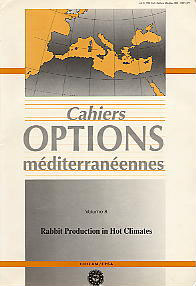| Article précédent | p. 131-139 | Article suivant |
A study on using different energy levels for growing rabbits in Egypt
Forty eight male NZW rabbits of 49 days of age, with nearly equal live body weight at the beginning of the experiment were randomly allotted to three treatment groups of 16 rabbits each. Treatment groups were fed diets with different energy levels. The first group was used to be fed on a high energy diet (2707 kcal De/kg) and the other two groups on medium (2436 kcal De/kg) and low (2276 kcal De/kg) energy diets, respectively. The rabbits were raised under the same managerial and hygienic conditions, in windowed rabbitry and in flat-deck batteries under semi-intensive production system. The results did not show any significant difference due to different dietary energy levels on live weight, weight gain, feed conversion. The results show that the economical efficiency was higher for low energy diet than the corresponding in high and medium energy diets. The digestibility of the nutrients, carcass traits and most of blood constituents did not differ significantly among the three dietary energy levels fed to the three rabbit groups. The low energy diet is more profitable than the medium and high energy ones for growing rabbits up to marketing age (133 weeks).
- [ Afficher ]
- [ Télécharger ]
- [ Exporter la citation ]
Vous pouvez télécharger la citation au format :
- [ Imprimer ]
-
Mots-clés
DIGESTION, LAPIN, NUTRITION ANIMALE, REGIME ALIMENTAIRECiter cet article
Ayyat M.S., Yamani K.A.O., Bassuny S.M., El Gendy K.M., Abdalla M.A. A study on using different energy levels for growing rabbits in Egypt. In : Baselga M. (ed.), Marai I.F.M. (ed.). Rabbit production in hot climates. Zaragoza : CIHEAM, 1994. p. 131-139. (Cahiers Options Méditerranéennes; n. 8). 1. International Conference of rabbit production in hot climates, 1994/09/06-08, Cairo (Egypt). http://om.ciheam.org/om/pdf/c08/95605285.pdf



